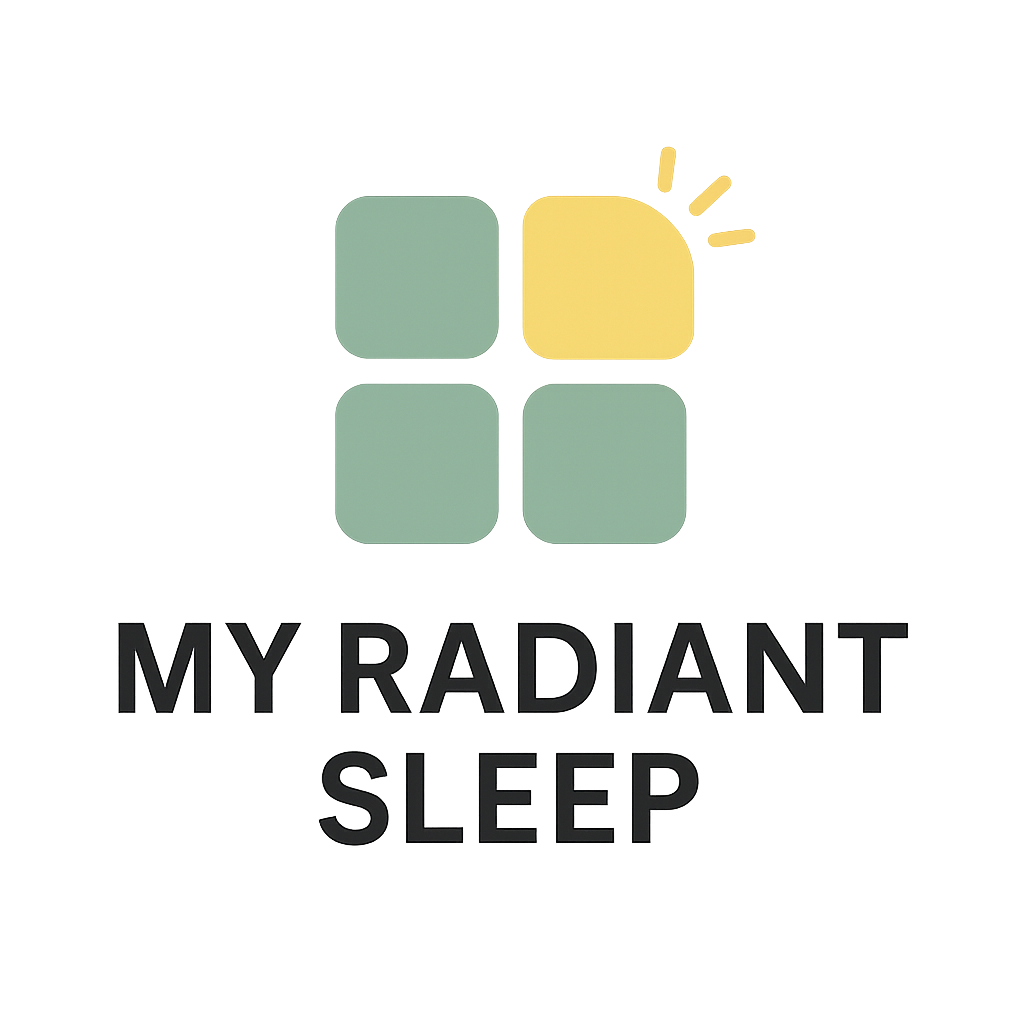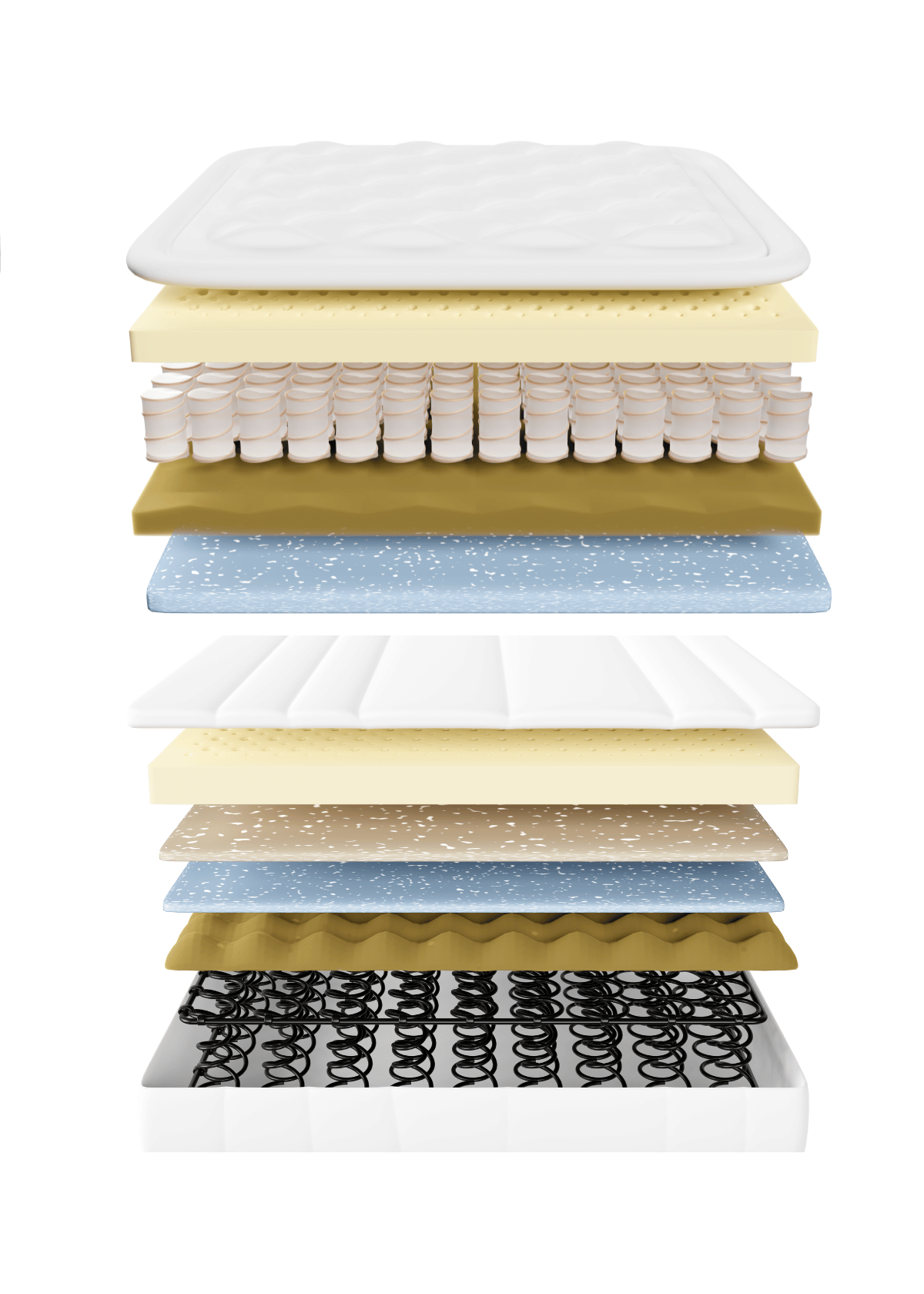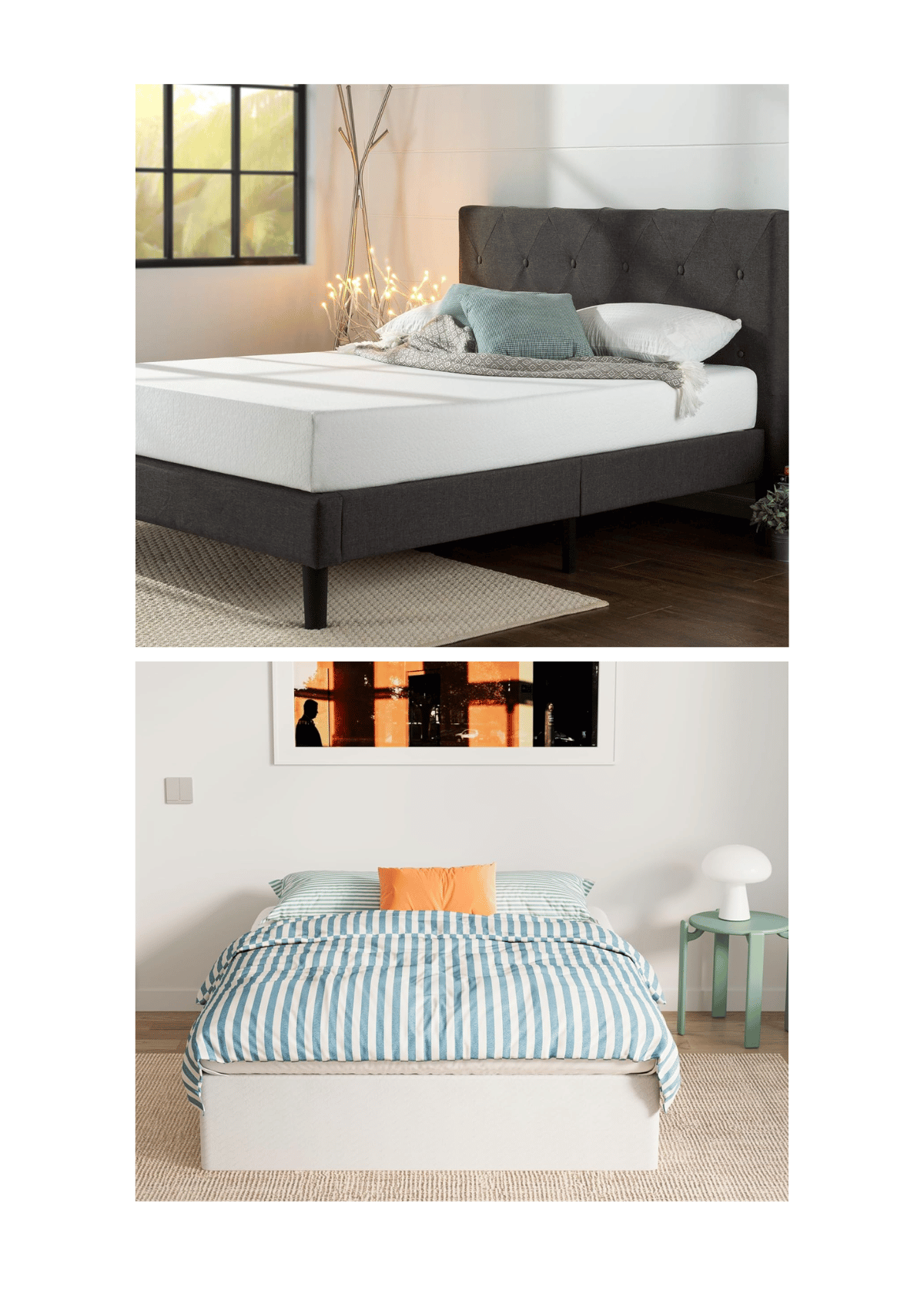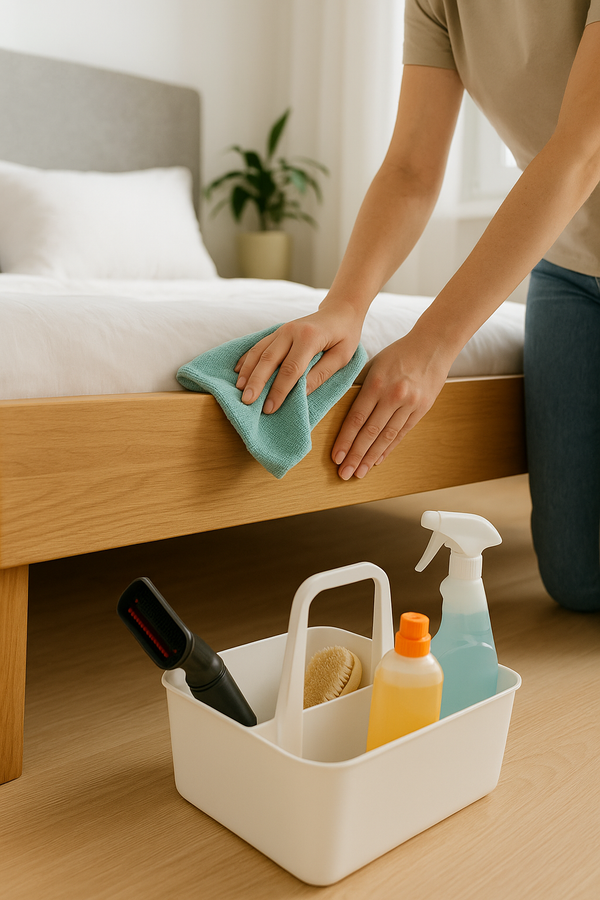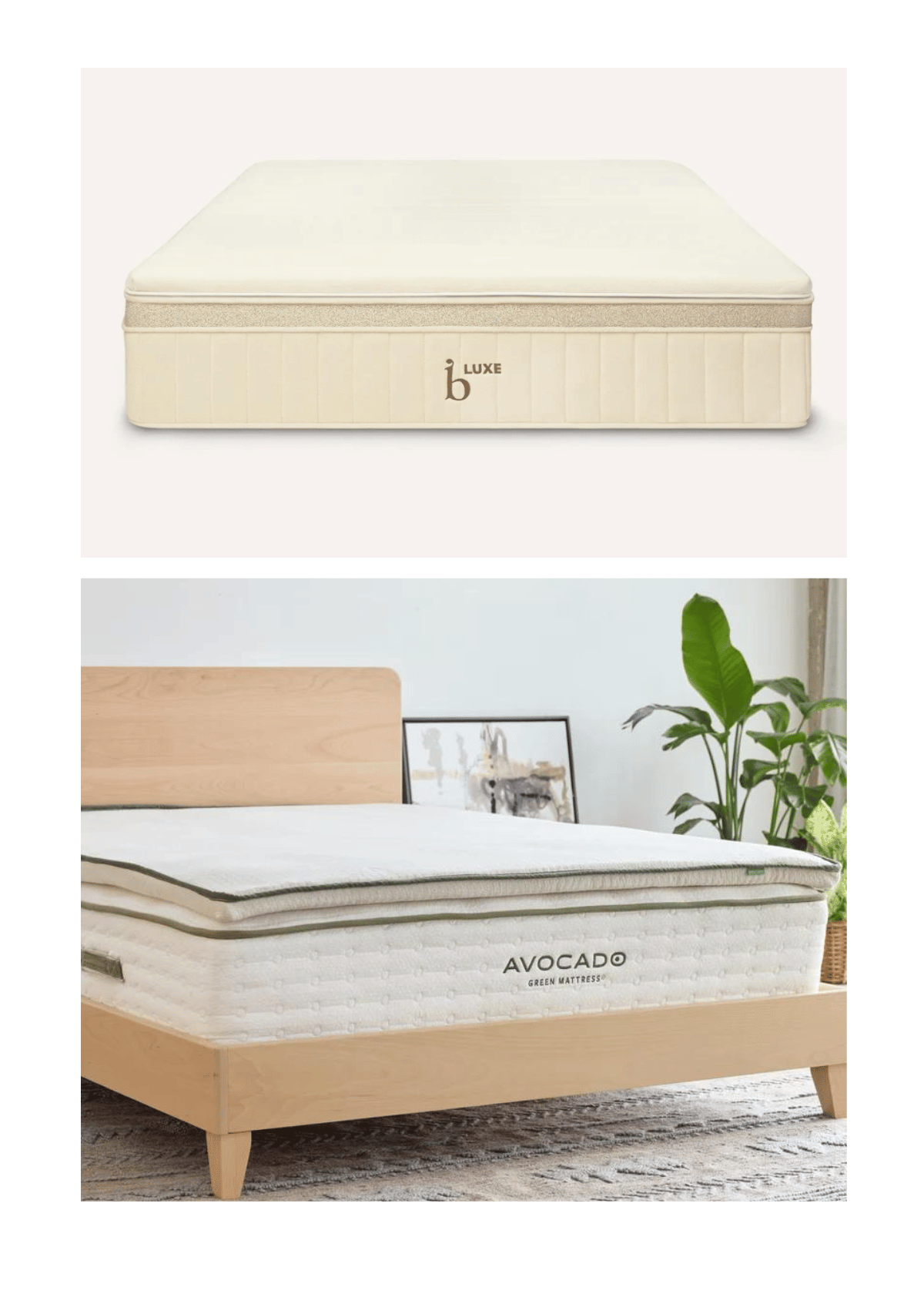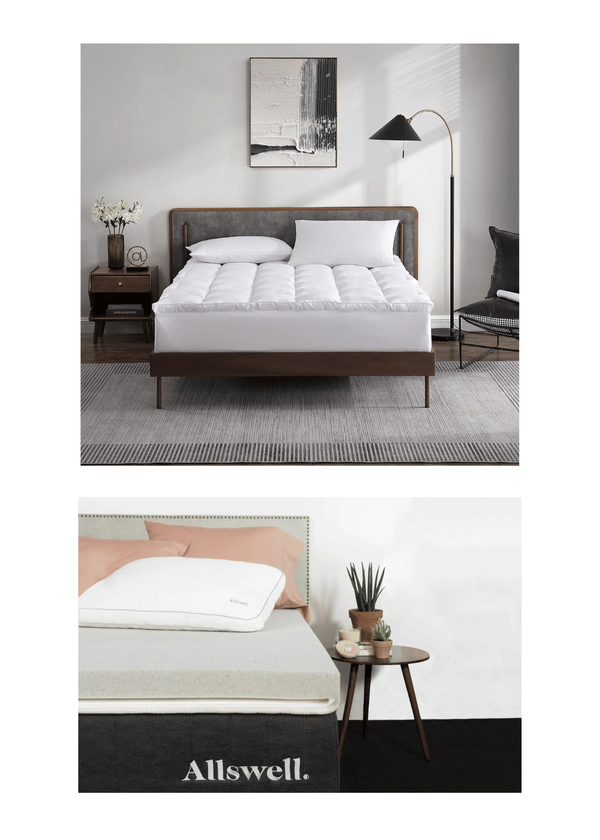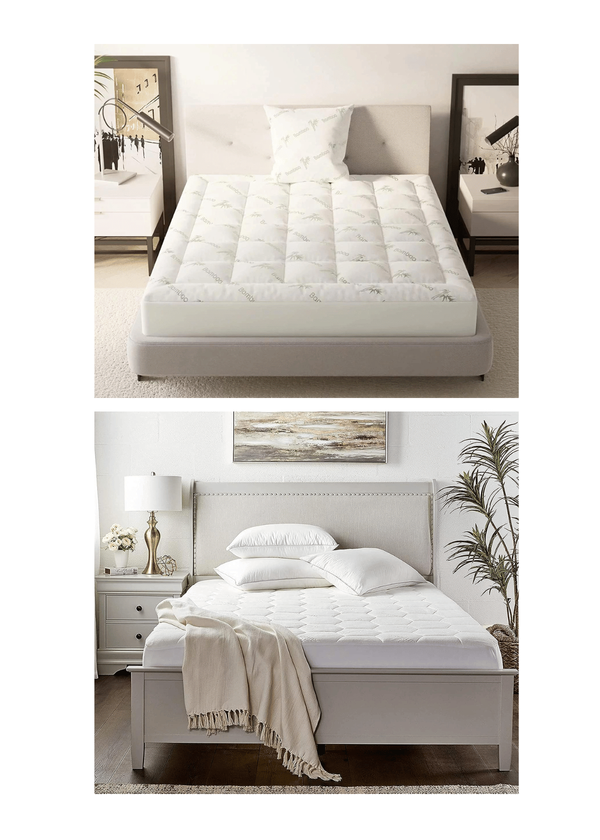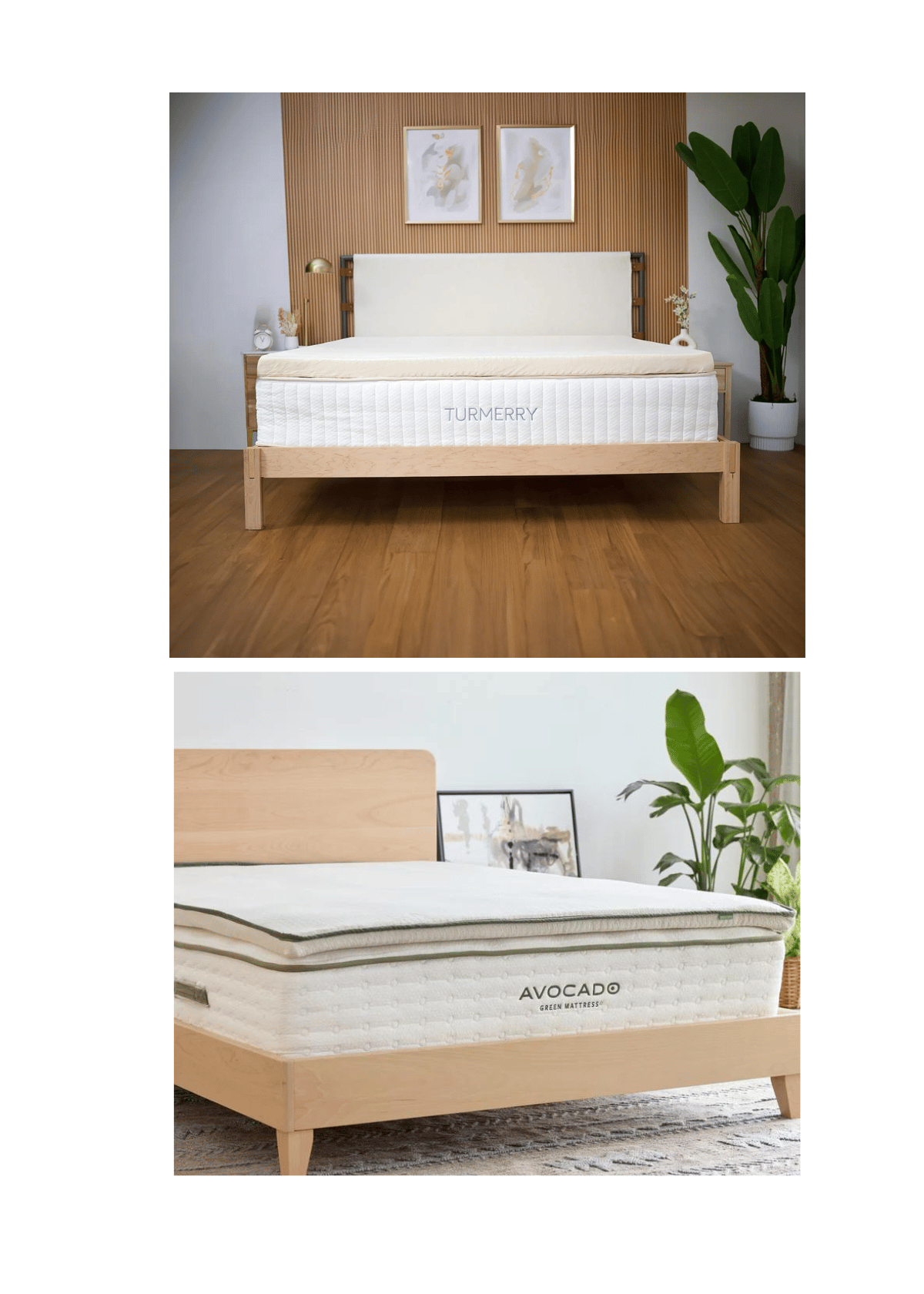(Last Update: 04/06/2025)
A good night's sleep is essential for optimal health and well-being.
As we spend nearly one-third of our lives in bed, it's crucial to invest in a mattress that provides the perfect balance of comfort and support.
This guide explores the three popular mattress materials- memory foam, latex, and innerspring- to help you make an informed decision.
In the following sections, we will delve into the details of each material, discuss their pros and cons, and provide an overview of the top brands.
We will also touch upon hybrid beds, which combine the best features of these materials. Finally, we can offer guidance on choosing the right mattress material based on your unique preferences and needs.
Understanding the key differences between memory foam, latex, and innerspring mattresses can help you make a well-informed choice that ensures a restful and rejuvenating night's sleep.
So, let's embark on this journey towards better slumber and improved quality of life.
Types of Mattresses
Innerspring, foam, latex, and hybrid are the four main mattresses available.
Most mattresses are designed to offer a balance of comfort and support, accommodating various sleep preferences and body types.
However, mattresses at a lower price point can still provide comfort and support, making quality sleep accessible to a wider range of budgets.
- Innerspring Mattresses: These mattresses feature a support core made of metal coils, offering durability and adequate support. They often include pillow tops for extra cushioning.
- Foam Mattresses: Memory foam and egg crate foam are common. They are known for their contouring properties, which reduce pressure points and alleviate morning aches.
- Latex Mattresses: Made from natural latex derived from rubber trees, these mattresses offer excellent durability and support. They are ideal for those with material preferences leaning towards natural and hypoallergenic options.
- Hybrid Mattresses: Combining innerspring coils and foam layers, hybrid mattresses provide the best of both worlds. Certain hybrid models are designed to offer extra cushioning and support.
Section 1: Memory Foam Mattresses
Understanding Memory Foam Technology
Memory foam, also known as viscoelastic foam, was first developed by NASA in the 1960s to improve the safety and comfort of aircraft cushions.
Over the years, this innovative material has entered the mattress industry due to its unique pressure-relieving properties.
Memory foam is a temperature-sensitive, flexible polyurethane foam that responds to your body's heat and weight to contour your unique shape.
This foam characteristic provides personalized support and even weight distribution.
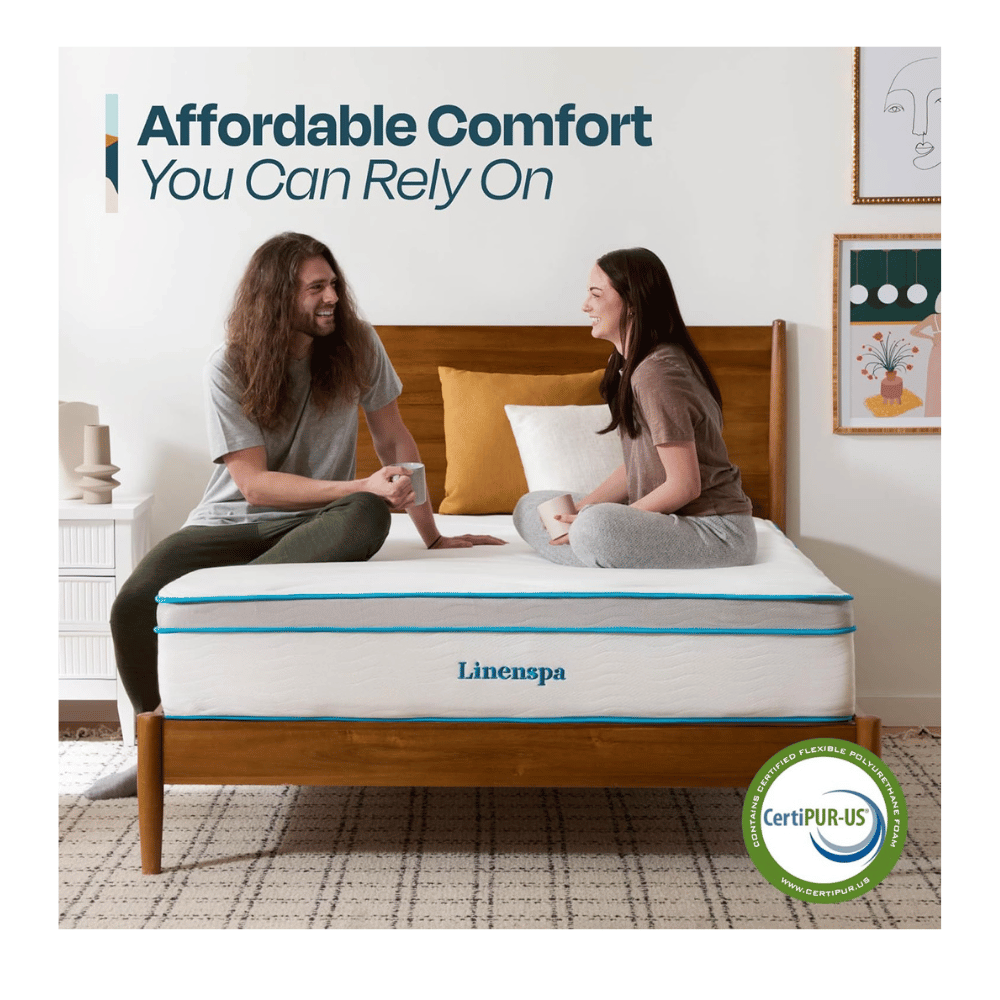
Foam mattresses are renowned for reducing pressure points and alleviating morning aches.
Foam mattresses conform to the body's shape. Available in various densities, they cater to different material preferences, ensuring a suitable option for every sleeper.
Pros and Cons of Memory Foam Mattresses
Pros:
Pressure point relief
Memory foam mattresses are well-known for alleviating pressure points by contouring the body's curves.
Motion isolation
The dense structure of memory foam and memory-thin mattresses absorbs movement, preventing motion transfer between sleeping partners. This makes foam beds ideal for light sleepers or couples with different sleep schedules. A thin mattress is often preferred for its lightweight and easy maneuverability.
Hypoallergenic: Memory foam beds are less likely to harbor allergens, such as dust mites, than traditional innerspring mattresses, making them suitable for allergy sufferers.
Low maintenance:
Foam beds do not require flipping or rotating, and their single-sided design makes them easy to care for.
Cons:
Heat retention:
Traditional memory foam mattresses are known for retaining body heat, which can make them feel too warm for some sleepers.
However, newer memory foam technologies, such as gel-infused or open-cell foam, help to mitigate this issue.
Off-gassing: When new, memory foam beds may release a noticeable odor, known as off-gassing. This smell usually dissipates within a few days but can be bothersome for some individuals.
Slow response time: Foam can have a slow response time due to its viscoelastic nature.
Initial cost: Although they tend to have longer lifespans, high-quality foam beds can be more expensive than other mattresses.
Types of Memory Foam: Traditional, Open-Cell, and Gel-Infused
Traditional Memory Foam: Traditional foam is the original viscoelastic foam that conforms to the body and offers excellent pressure point relief. However, any of these gel mattresses are known for retaining heat and may not suit hot sleepers.
Open-Cell Memory Foam:
Open-cell foam features a more breathable structure than traditional memory foam. The open-cell technology allows for better airflow.
These gel mattresses are ideal for sleepers who prefer the feel of foam but are concerned about heat retention.
2.4 Best Memory Foam Mattress Brands
Tempur-Pedic: Tempur-Pedic is a pioneer in the memory foam mattress industry and offers a wide range of high-quality mattresses with varying firmness levels and features. Their mattresses are known for their durability and motion isolation.
Nectar:
Nectar mattresses offer an affordable balance of comfort and support. They are memory foam mattresses constructed with multiple layers of foam.
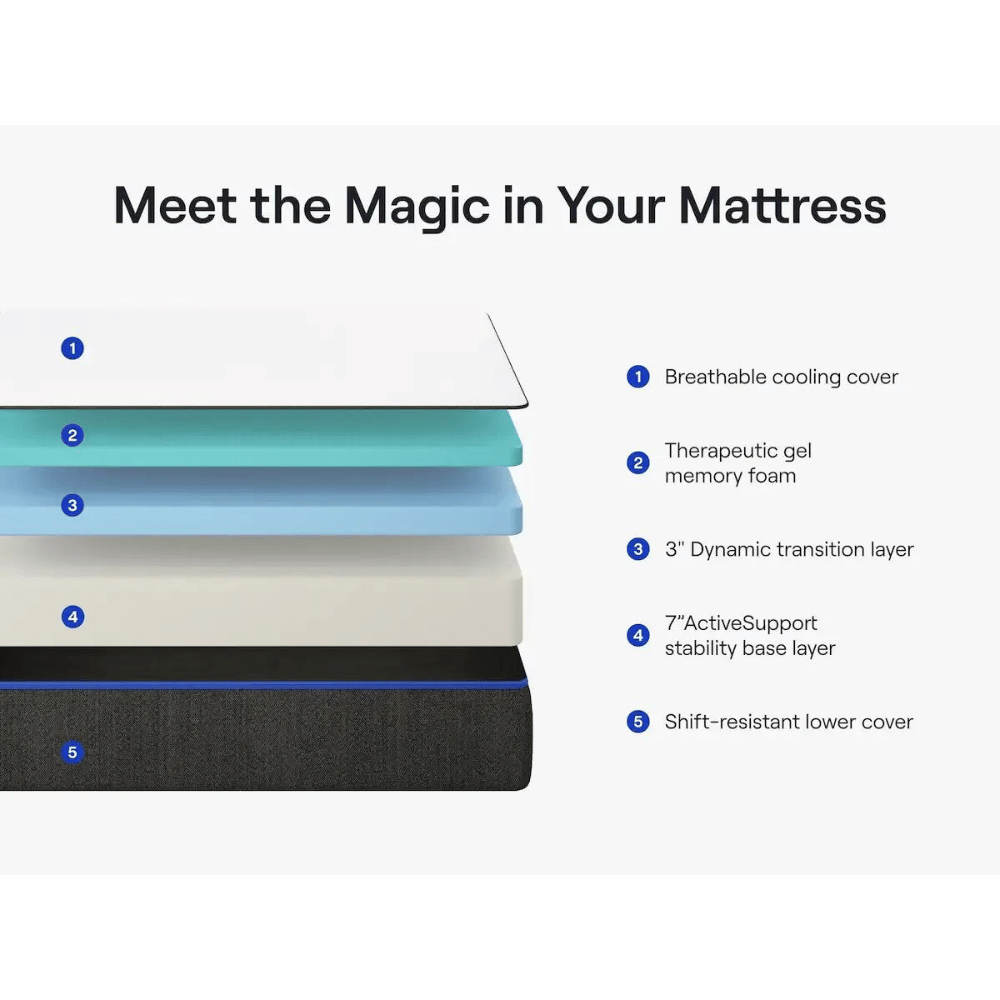
Casper:
Casper's memory foam mattresses: Casper's foam beds are designed with open-cell and high-density foams to balance support and pressure-relieving points.
Leesa:
The Leesa mattress uniquely combines foam and polyfoam layers. The mattress is designed to adapt to various sleep positions and body types.
Loom & Leaf:
Loom & Leaf, a subsidiary of Saatva, offers luxury memory foam mattresses with eco-friendly materials and cooling gel-infused foam layers.
When selecting the best memory foam mattress types, consider factors such as heat retention, mattress firmness level, and individual sleeping preferences. By comparing different foam mattress brands and technologies, you can find the perfect mattress option that offers the comfort and support needed for a restful night's sleep.
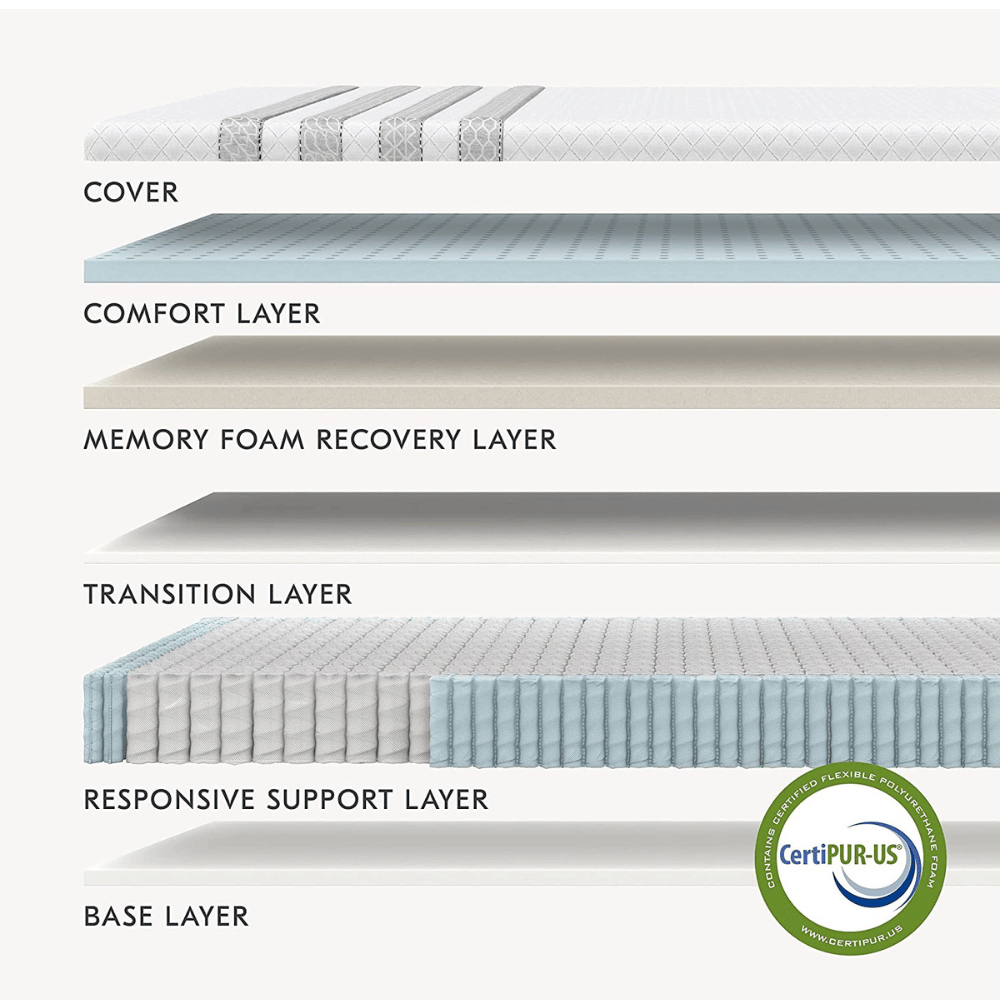
Section 2: Latex Mattresses
Natural vs. Synthetic Latex: What's the Difference?
Latex is derived from the sap of the rubber tree (Hevea brasiliensis) and is known for its resilience, durability, and natural elasticity. Two main types of latex are used in the mattress: natural and synthetic.
Natural latex is made from 100% natural rubber tree sap and processed using the Dunlop or Talalay method. Latex is eco-friendly, hypoallergenic, and biodegradable.
Conversely, synthetic latex is made from latex and synthetic materials, such as styrene-butadiene rubber (SBR). It is less expensive than latex but may provide a different level of support, durability, and breathability than its natural counterpart.
Latex mattresses, made from rubber trees, are celebrated for their durability and support.
They are a great choice for those with specific material preferences and a focus on natural, hypoallergenic options.
Latex mattresses offer a unique blend of comfort and support for various sleepers.
Pros and Cons of Latex Mattresses
Pros:
Support and comfort: Latex mattresses offer excellent support and pressure relieving points by contouring the body without the sinking feeling often associated with memory foam beds.
Responsiveness:
Latex is naturally elastic and quickly responds to changes in pressure.
Breathability:
Latex mattresses are known for their temperature regulation. Their open-cell structure promotes airflow and dissipates heat.
Durability:
High-quality latex mattresses have a longer lifespan than other mattresses, often lasting up to 15 years or more.
Hypoallergenic:
Latex is resistant to dust mites, mold, and mildew, making it an excellent mattress for allergy sufferers.
Cons:
Weight:
Latex mattresses can be heavy, making them difficult to move or transport.
Initial cost:
High-quality latex mattresses, especially those made of natural latex, can be expensive compared to other mattress types.
Limited availability:
Latex mattresses may not be as widely available as foam or innerspring mattresses.
Noise: While latex mattresses are generally quiet, they can sometimes produce a slight noise when bearing weight, which may be bothersome for some sleepers.
Dunlop vs. Talalay Latex: A Comparison
Dunlop and Talalay are the two primary methods of processing latex, and each produces a slightly different feel and performance.
Dunlop latex is created by pouring liquid latex into a mold. The mold is then vulcanized or heated to create a solid foam.
The process results in denser, firmer, and more durable latex. Due to its firmness, Dunlop latex is often used as a support layer in most latex beds and most foam mattresses.
Talalay latex involves a complex process. First, the liquid latex is poured into a mold, then vacuum-sealed and flash-frozen before being vulcanized.
Talalay latex is often used in the layers of latex mattresses due to its plush feel and superior pressure-relieving properties.
Best Latex Mattress Brands
PlushBeds: PlushBeds is an organic mattress company that offers a range of natural latex mattresses made with organic materials and customizable firmness levels.
Their mattresses are known for their durability, breathability, and superior comfort.
Avocado:
Avocado is an eco-friendly brand specializing in natural and latex organic mattresses.
Their mattress combines all-natural materials like latex, organic cotton, and wool to provide a comfortable, supportive, and sustainable sleep experience.
Zenhaven:
Zenhaven, another subsidiary of Saatva, offers luxury Talalay latex mattresses with a flippable design. Their mattresses provide excellent motion isolation and breathability.
Awara:
Awara's latex hybrid beds combine a layer of organic Dunlop latex with individually wrapped coils for a balanced and supportive sleep surface.
The mattress is designed to provide spinal alignment and temperature regulation.
Sleep on Latex:
Sleep on Latex offers affordable, all-natural latex mattresses made with high-quality materials.
When choosing a latex mattress type, consider factors such as natural vs. synthetic, like latex, processing method (Dunlop or Talalay), mattress firmness level, and individual sleeping preferences.
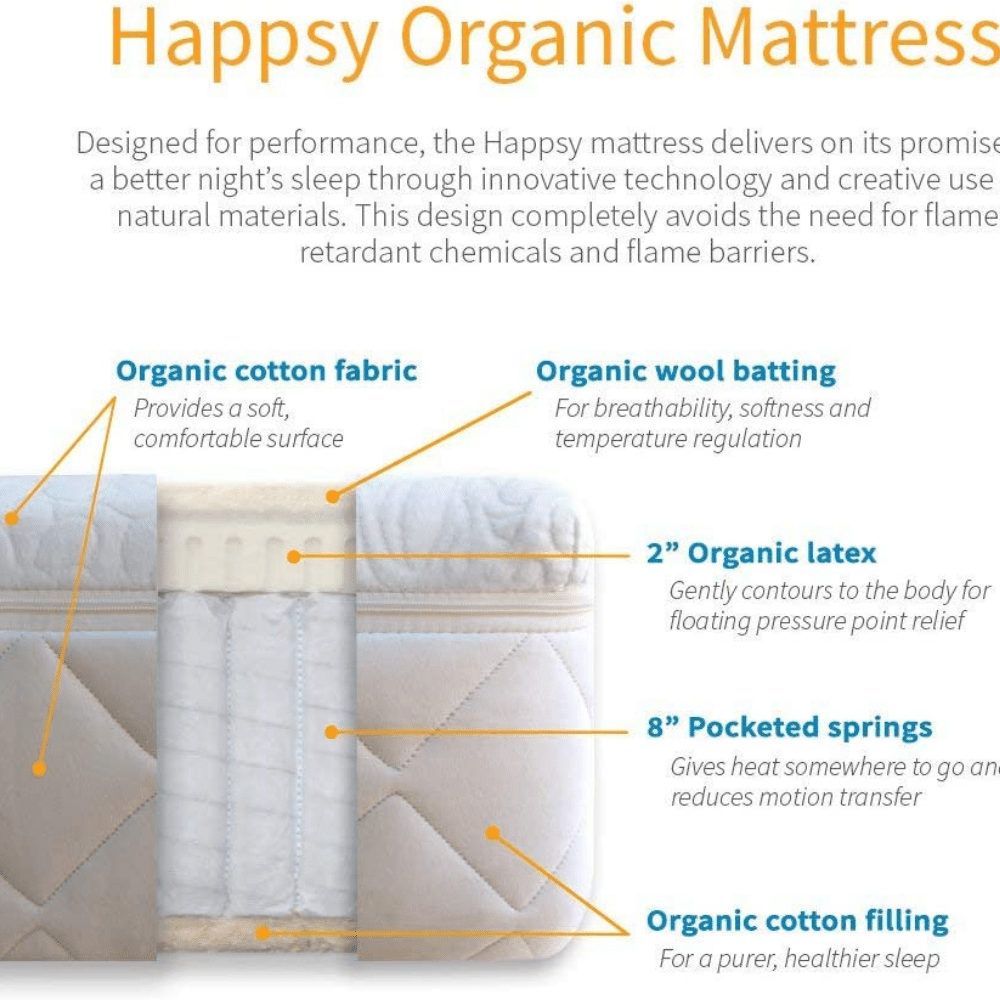
Section 3: Innerspring Mattresses
Understanding Innerspring Mattress Construction
Innerspring mattresses are the most traditional and widely available type of mattress, featuring a core of steel coils that provide support and bounce. The mattress has multiple layers, including the coil support system and a quilted or padded cover.
- Organic mattresses' comfort layers are typically made from foam, fiber, or both. They provide cushioning, while the coil system offers support and responsiveness.
- Several types of coil systems are used in an innerspring, such as Bonnell coils, offset coils, continuous coils, and pocketed coils (also known as Marshall coils or encased coils).
- Innerspring mattresses are a staple in traditional mattress designs.
They provide adequate support for various sleeping positions
Their manufacturing process often includes pillow tops, which add extra cushioning, enhancing overall comfort.
Pros and Cons of Innerspring Mattresses
Pros:
- Affordability: An innerspring bed is often more affordable than memory foam or latex mattresses.
- Responsiveness: The coil system in innerspring mattresses provides a bouncy and responsive sleep surface, which many sleepers prefer.
- Cooling: Innerspring mattresses are known for their excellent temperature regulation. This is due to the open coil structure, which promotes airflow and prevents heat buildup.
- Wide availability: The innerspring mattress types are widely available.
Cons:
- Limited pressure point relief: A traditional innerspring bed may provide fewer pressure-relieving points than a memory foam or latex bed, which can be a concern for those with joint pain or pressure point issues.
- Motion transfer: Innerspring beds, especially those with interconnected coil systems, are more likely to transfer motion between the same bed and sleeping partners, which can be disruptive for light sleepers.
- Durability: Innerspring mattresses tend to have a shorter lifespan than memory foam or latex mattresses, and the coils can potentially lose their supportiveness or become noisy over time.
Types of Coil Systems: Bonnell, Offset, Continuous, and Pocketed
Not all mattresses are created equal. Bonnell coils are the oldest and most traditional coil mattress type. They offer a supportive and durable sleep surface but may transfer motion more than other coil mattress types.
Offset Coils:
Offset coils are similar to Bonnell coils but feature a squared-off head, which allows them to conform more closely to the body. This design provides better pressure relief and motion isolation than Bonnell coils.
Continuous Coils:
Continuous coil systems comprise a single, continuous piece of wire that forms the entire mattress and coil structure. These mattresses offer a firm, supportive sleep surface but may have limited motion isolation.
Pocketed Coils:
Pocketed coils are individually wrapped in fabric or foam.
Best Innerspring Mattress Brands
Saatva:
Saatva offers luxury innerspring mattresses with individually wrapped coils and high-quality foams. These mattresses provide a supportive and comfortable sleep experience and are known for their durability, edge support, and customizable firmness options.
Beautyrest:
Beautyrest is a well-established organic mattress brand offering a range of innerspring beds with various coil systems and comfort materials. Their mattresses are designed to provide targeted support and motion isolation and are better than others.
Sealy:
Sealy is another well-known affordable mattress top brand that offers various spring mattress models with different coil systems, comfort layers, and firmness levels. Their mattresses are designed to cater to a wide range of sleep preferences and budgets.
Stearns & Foster:
Stearns & Foster specializes in luxury innerspring beds, focusing on craftsmanship, quality, natural materials, and attention to detail. Their mattresses feature pocketed coil systems and high-quality foams.
Serta:
Serta offers a range of innerspring bed options, including the popular Perfect Sleeper and iComfort lines. Their mattresses are designed to balance support, comfort, and motion isolation and are suitable for various sleep positions and body types.
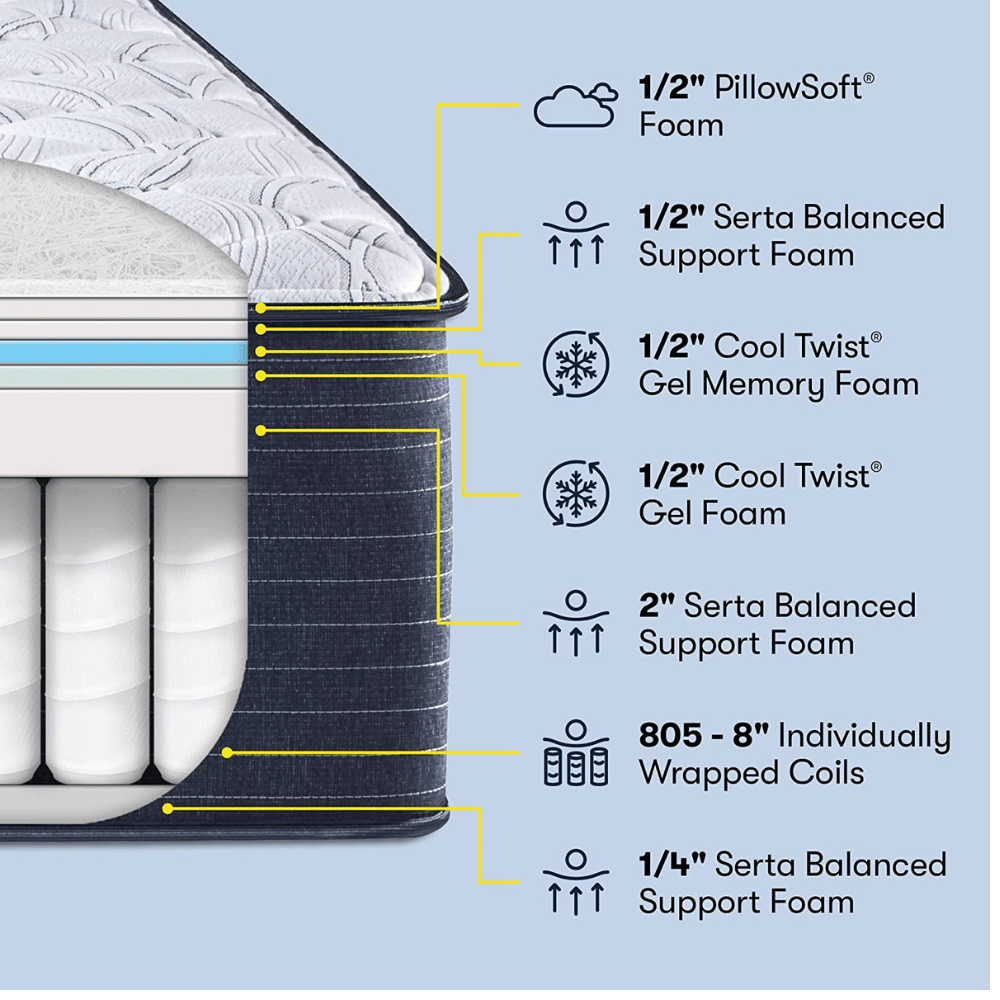
Section 4: Hybrid Mattresses: Combining the Best of All Worlds
Understanding Hybrid Mattress Construction
Hybrid mattresses combine the best features of memory foam, latex, and innerspring mattresses to provide a balanced and comfortable sleep experience.
These mattresses typically feature a coil support system (usually pocketed coils) paired with one or more foam or latex layers and an innerspring core as the comfort layer.
The combination of materials allows hybrid mattresses to offer the pressure-relieving feature and contouring of most foam beds or latex with the support and responsiveness of innerspring coils.
The comfort layer in hybrid beds can consist of various materials, such as memory foam, latex foam, gel foam, or even specialty foams like cooling or pressure-relieving foams. In addition, the mattress cover of this hybrid mattress type is usually made from breathable fabrics like cotton or polyester to promote airflow and temperature regulation.
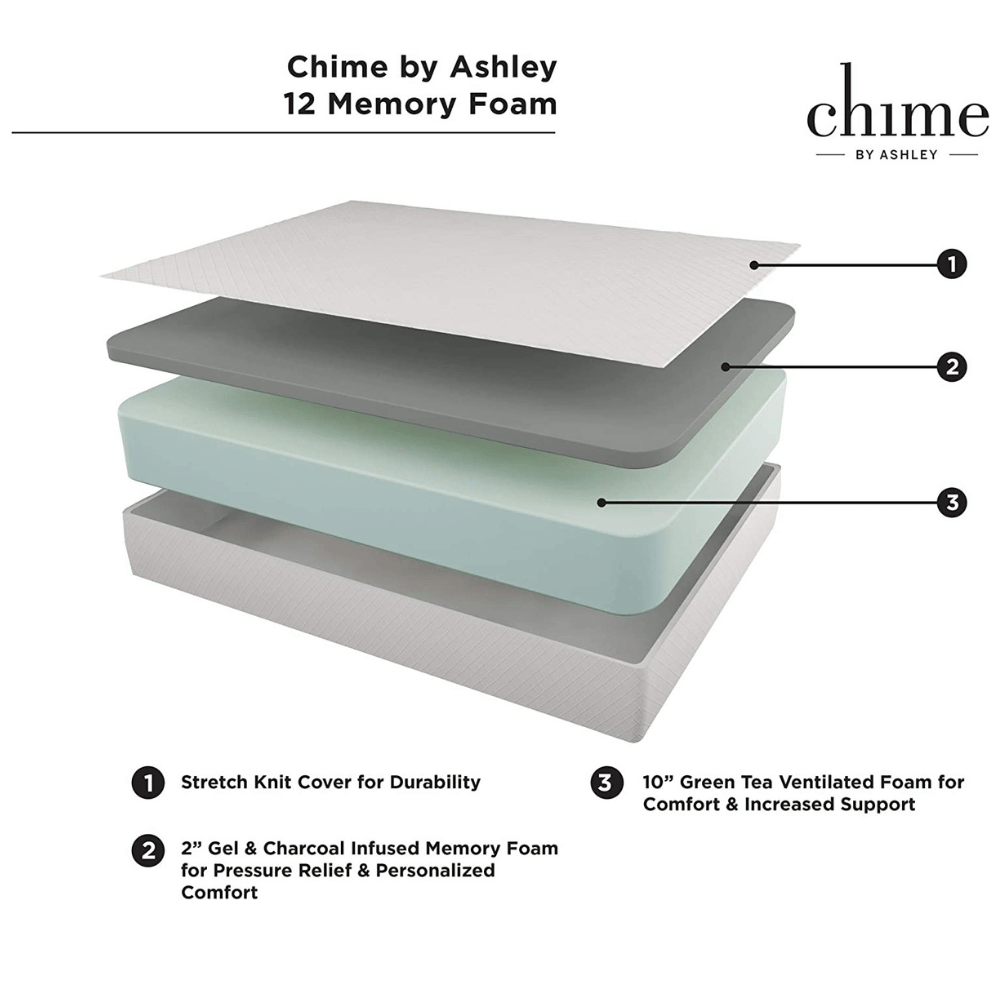
Hybrid mattresses combine the benefits of innerspring and foam mattresses, offering a balanced sleep experience.
With multiple chambers and advanced designs, certain hybrid models provide more support and reduce pressure points effectively.
They cater to various sleeping positions and preferences.
Pros and Cons of Hybrid Mattresses
Pros:
- Balanced feel: Hybrid mattresses provide a balanced feel, combining the pressure relieving points relief and contouring of foam or latex with the support and bounce of innerspring coils.
- Temperature regulation: Combining airflow-promoting coils and breathable foams or latex can help maintain a neutral sleep temperature.
- Motion isolation: Hybrid beds offer excellent motion isolation, especially those with pocketed coils.
- Customizability: Hybrid mattresses have various comfort layer materials and firmness levels,
Cons:
- Weight: Due to the combination of materials, hybrid mattresses can be quite heavy, making them difficult to move or transport.
- Cost: A high-quality hybrid mattress can be more expensive than traditional innerspring or foam mattresses.
- Off-gassing: When new, hybrid mattresses with foam layers may produce off-gassing odors similar to memory foam mattresses.
- Durability: While hybrid mattresses are generally durable, their lifespan may vary depending on the materials' quality than other types of mattresses.
Best Hybrid Mattress Brands
Helix:
Helix offers a range of customizable hybrid beds with different firmness levels, comfort materials, and support systems to cater to various sleep preferences and body types.
WinkBeds:
WinkBeds specializes in luxury hybrid mattresses, which combine high-quality foams with pocketed coils to provide a comfortable, supportive, and durable sleep experience.
Purple:
Purple's unique hybrid mattresses feature their proprietary Purple Grid™ comfort layer, made from hyper-elastic polyurethane foam. This layer provides excellent pressure-relieving points relief, breathability, and responsiveness.
DreamCloud:
Dream Cloud's hybrid beds combine memory foam, latex, and coils for a balanced, comfortable sleep surface that adapts to different sleep positions and body types.
When considering hybrid mattress types, consider the mattress comfort layer materials, coil system, firmness level, and individual sleeping preferences. Then, by comparing different hybrid mattress options, brands, and technologies, you can find the perfect option that offers the comfort and support needed for a restful night's sleep.
Section 4: Air Mattresses
Air mattresses offer a unique and versatile sleep solution, making them popular for various situations. Some of the notable features and benefits of air mattresses include:
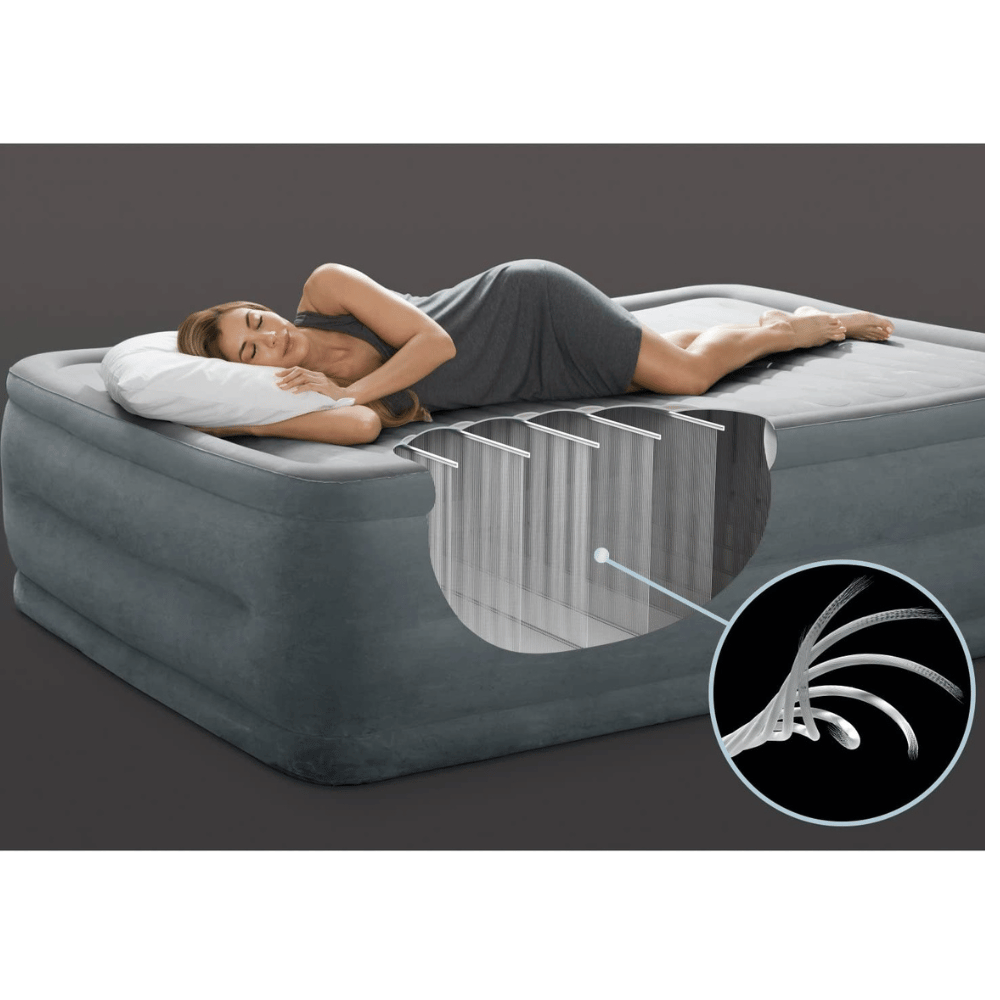
Customizable firmness
One of the main advantages of air mattresses is their adjustable firmness level. By inflating or deflating this type of firm mattress, you can easily customize the support and comfort to your preference.
Air Chambers: Air Mattresses are made of air chambers and are often used for temporary sleeping arrangements or camping. They are portable and can be inflated or deflated to achieve the desired firmness.
Portability and storage:
Air mattresses are lightweight and can be deflated and folded for easy transport and storage. This makes them ideal for camping, traveling, or accommodating guests in limited space.
Durability:
A High-quality air mattress is constructed with puncture-resistant materials, ensuring it remains intact and functional even with regular use. Many models also come with repair kits for easy maintenance.
Cost-effective:
- Air mattresses are often more affordable than traditional mattresses, making them an attractive option for those on a tight budget or looking for a temporary sleep solution.
- Easy setup: Setting up an air mattress type is quick and straightforward, usually requiring only an air pump (either manual or electric) to inflate it within minutes.
- While air mattresses may not be the best long-term solution for everyday use, their versatility, customizability, and convenience make them valuable for various situations, such as camping and temporary accommodations.
- In addition, they are more versatile in their use than other types of mattresses.
Section 6: How to Choose the Right Mattress Material for You
Assess Your Sleeping Preferences
Before choosing a material, please look at your sleeping preferences and needs. Consider the following factors:
- The best mattress for each individual depends on their comfort, sleep needs, and material preferences.
- Prioritizing sleep health involves choosing a mattress that supports proper spinal alignment and promotes deep, restorative sleep.
- Sleep position: Your preferred sleep position can influence the type of mattress that suits you best. Side sleepers may benefit from the pressure relieving points relief provided by memory foam or latex.
- Firmness level: Different materials offer various firmness levels, so understanding your mattress preference is crucial. Gel-infused foams and latex can be found in various firmness levels, while innerspring mattresses often provide a firmer feel.
- Temperature regulation: If side sleepers sleep hot, consider materials that promote airflow and dissipate heat, such as innerspring or latex beds. Memory foam mattresses with gel-infused or open-cell technology can also help regulate temperature.
Consider Your Body Type and Weight
Your body type and weight can impact how different materials feel and perform:
Lightweight sleepers (under 130 lbs): To provide adequate contouring, lightweight individuals might prefer firm mattresses or softer materials, such as memory foam or soft latex. Firm mattresses, innerspring, or hybrid beds may feel too hard for them.
Average-weight sleepers (130-230 lbs): An average mattress topper of weight, individuals can usually find comfortable soft mattresses in various materials and firmness levels. Depending on personal preferences, memory foam, latex, innerspring, and hybrid beds can all provide a comfortable and supportive sleep surface.
Heavyweight sleepers (over 230 lbs): Heavier individuals may benefit from firmer and more supportive materials, such as latex foam or hybrid beds with a robust coil system. Foam mattresses may feel too soft or unsupportive for heavyweight sleepers.
Factor in Any Health or Allergy Concerns
If you have health or allergy concerns, please consider them when selecting a pillow top material. Pillow-top mattresses boast an additional cushioning layer. A pillow-top mattress offers a plush and luxurious feel. All pillow-top mattresses excel in providing pressure relief, contouring support, and improved sleep quality:
Allergies: If you suffer from allergies, consider hypoallergenic materials like latex, resistant to dust mites, mold, and mildew. Some foam mattresses also have hypoallergenic properties, but it's essential to verify the specific materials used.
Joint pain or pressure points: If you experience joint pain or pressure point issues, consider materials that provide excellent contouring, such as foam or latex foam.
Test Mattresses and Read Reviews
When selecting a material, testing different options in person is essential. Visit mattress stores or showrooms to experience the feel and support of various materials. Remember that the in-store experience may not precisely replicate long-term use, but it can provide valuable insight into your preferences.
In addition to testing most mattresses, I read customer reviews and expert opinions on different materials and brands. Reviews can offer insights into durability, support, comfort, and potential issues or concerns.
Set a Budget and Compare Mattress Brands.
Establishing a budget is an essential step in choosing the right material. Different materials come at varying prices, with foam and innerspring mattresses often more affordable than latex or high-quality hybrid options.
How much will you invest in a new mattress and compare the offerings from various brands within your budget?
When comparing mattress brands, consider factors such as the quality of materials, warranty, trial period, and customer support. Many online mattress companies offer extended trial periods.
Conclusion
This comprehensive guide explored various materials, including foam, latex, innerspring, and hybrid options.
Each material offers distinct advantages and drawbacks, catering to different sleep preferences and needs.
By understanding each material's characteristics, you can make an informed decision about selecting a mattress that best suits your unique needs.
To choose the right mattress material, consider your preferred sleep position, firmness level, body weight, temperature regulation needs, and any health or allergy concerns.
Ultimately, you need to set a budget, test mattresses in person or have them delivered to you for a test, and read reviews from other mattress shoppers to gain insights into the performance and durability of different materials and brands.
Mattress Material FAQs
What are the pros and cons of memory foam mattresses?
Memory foam mattresses are known for their pressure relief, contouring, and motion isolation. However, they may retain heat and produce off-gassing odors.
How do latex mattresses compare to foam and innerspring beds?
Latex mattresses are durable, supportive, and temperature-neutral. They offer a balance of pressure relief and support. They follow the Global Organic Textile Standard and the Global Organic Latex Standard guidelines, making them suitable for various sleep positions. Latex is also hypoallergenic and eco-friendly.
What should I consider when choosing an innerspring mattress?
When choosing an innerspring bed, consider factors such as coil type, count, and gauge. Popular innerspring mattress brands include Saatva, Sealy, and Serta, known for their quality, support, and durability.
How do hybrid mattresses blend different materials, and what are their pros and cons?
Hybrid mattresses combine the pressure relief of memory foam or latex with the support and responsiveness of innerspring coils. They offer a balanced feel, temperature regulation, and motion isolation in all foam beds. However, they can be heavy and more expensive than other mattress types.
How do sleep preferences, body type, and health affect mattress material choice?
When choosing a mattress material, consider your preferred sleep position, firmness level, body weight, temperature regulation needs, and health or allergy concerns. These factors can help you find the perfect material that offers the comfort and support you need.
What materials are adjustable beds made of?
Adjustable beds typically feature sturdy metal springs or steel frames, which provide durability and support. The base may include a combination of wood, metal, or plastic components. At the same time, the mattress can be made from memory foam, latex, or specially designed innerspring materials.
What materials are used in a mattress topper?
Mattress toppers enhance comfort and support using foam, latex, down or down alternatives, and wool. A memory foam or Latex mattress topper can relieve pressure and contour to the body, while down-and-down alternatives offer plush softness. Wool toppers provide natural temperature regulation and moisture-wicking properties.
